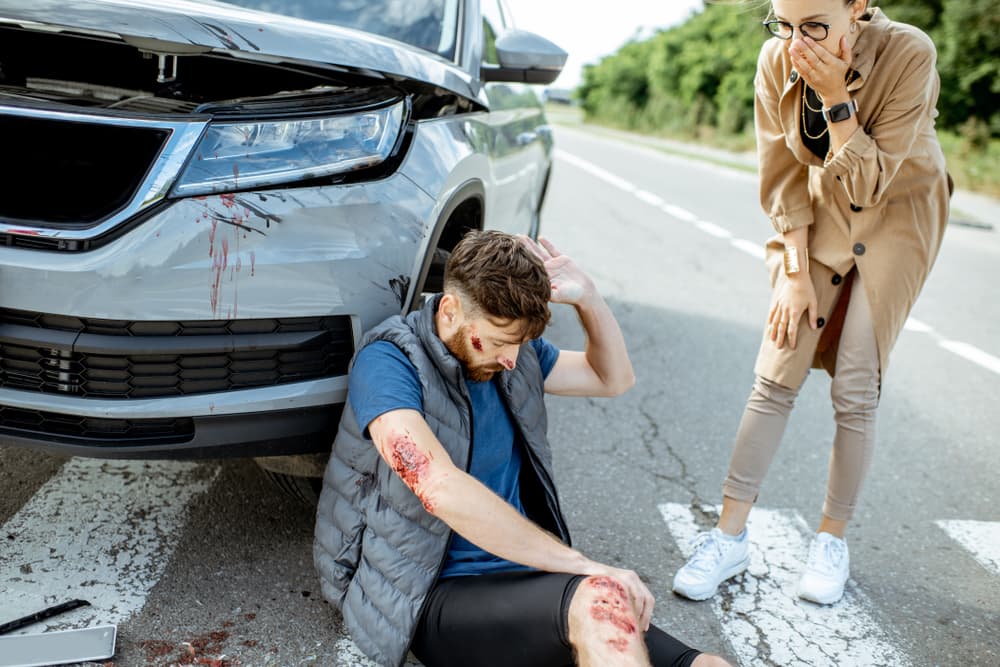Steven A. Bagen | October 3, 2023 | Pedestrian Accidents

If you are the victim of a pedestrian accident, you may wonder, “Do I need a pedestrian accident attorney?”
There are countless reasons to hire a pedestrian accident attorney, which include having an experienced negotiator to handle insurance companies. A clear understanding of the role a pedestrian accident attorney can play helps prepare you to navigate such an unfortunate experience.
Schedule a Free Consultation Today!
CAUSES OF PEDESTRIAN ACCIDENTS
Pedestrian accidents happen when a vehicle, such as a car, strikes a person. These incidents occur daily across the United States, and distracted driving is a significant contributor.
Distracted driving occurs when a driver engages in another activity, such as using a phone or eating, taking their attention away from the road. Lack of street lights, speeding drivers, and motorists who fail to observe traffic rules are other common causes of pedestrian accidents.
Pedestrian accidents often result from motorists driving under the influence of drugs or alcohol or disregarding pedestrian crosswalks. Weather conditions, such as heavy rain or fog, can also increase the risk of pedestrian accidents due to impaired visibility.
While these accidents can occur at any time, they are particularly prevalent during rush hour and peak periods when drivers and pedestrians are in a hurry, often resulting in the neglect of traffic rules.
Injuries Resulting From Pedestrian Accidents
Physical injuries from pedestrian accidents can range from minor cuts and bruises to severe injuries, such as broken bones, spinal cord injuries, traumatic brain injuries, or fatalities resulting in wrongful death claims.
Pedestrian accidents often inflict emotional trauma, which can be debilitating. As a victim, you may suffer post-traumatic stress disorder, anxiety, depression, or a fear of leaving the house or crossing streets.
A pedestrian accident can have significant repercussions on a victim’s social life and relationships. In such a situation, you may be unable to engage in your daily activities due to physical injuries or emotional distress. This can result in isolation and further contribute to mental health struggles. You may also experience a loss of confidence, especially when navigating public spaces or returning to the accident scene.
A pedestrian accident claim will encompass physical and emotional damages. A skilled attorney will consider all losses when determining your eligible compensation.
The Role of a Pedestrian Accident Attorney
A pedestrian accident attorney represents victims and their families who have suffered injuries in this type of incident. They are critical to ensuring injured parties receive the compensation they deserve for their losses.
Pedestrian accident attorneys are not just legal representatives; they also guide clients through the legal process. They understand the intricacies of pedestrian laws and can apply their knowledge to their client’s advantage.
A skilled pedestrian accident lawyer will gather evidence, review police and medical reports, communicate with insurance companies, and use their resources to build a strong case. They can also file a lawsuit and represent you in court if necessary.
An attorney can substantially improve your chances of receiving a fair settlement. A pedestrian accident attorney understands the tactics that insurance companies often use to minimize compensation and will work tenaciously to counter them.
How an Attorney Can Handle a Pedestrian Accident Case
A pedestrian accident attorney can explain your rights and provide invaluable legal advice. Your attorney can evaluate all your damages to ensure you get the maximum compensation, including medical bills, lost earnings, and pain and suffering. They will work relentlessly to seek the justice you deserve.
A pedestrian accident attorney carries the burden of the legal process so that you can focus on recovery. They act as your advocate and ensure you receive fair treatment during this challenging time.
When to Hire a Pedestrian Accident Attorney
There are several scenarios where hiring a pedestrian accident attorney is advisable. If an accident results in severe injuries or death, for instance, a skilled attorney can navigate the legal complexities.
Cases involving disputed liability uninsured at-fault parties may also warrant professional legal advice. An experienced pedestrian accident attorney can protect your rights and advocate for your interests.
Hiring a pedestrian accident attorney early in the process allows them to preserve evidence, secure witness testimonies, and build your case. There’s also a statute of limitations for filing a personal injury claim, which varies from state to state. Waiting too long might mean you lose your chance to file a claim.
Benefits of Hiring a Pedestrian Accident Attorney
A pedestrian accident can have devastating, long-term consequences, draining your financial resources and causing immense distress. One of the most effective ways to ease the burden is to hire a pedestrian accident attorney.
Hiring a pedestrian accident attorney can offer numerous benefits. They have the skills and knowledge to deal with complex legal procedures and understand the emotional trauma such accidents cause. They can reduce your stress by dealing with the insurance companies and legal paperwork on your behalf.
An attorney can also maximize your settlement. They understand the nuances of pedestrian accident cases and can accurately evaluate the compensatory damages you deserve, including medical expenses, lost earnings, future treatment costs, and pain and suffering.
A pedestrian accident attorney’s role is to ensure you get the maximum compensation for your losses. They achieve this by building a solid case using clear and convincing evidence, determining the full value of your claim, and negotiating on your behalf. Your attorney can thoroughly investigate your case, gather necessary evidence, interview witnesses, review police and medical reports, and consult experts when necessary. Their preparation and strategy can significantly strengthen your claim.
The Role of an Attorney in Insurance Company Negotiations
One of the most tedious and challenging aspects following a pedestrian accident is dealing with insurers. These companies typically have legal teams working to minimize what they pay. Insurance companies are profit-driven entities and may approach you swiftly and aggressively, offering an early settlement that may seem generous but is typically far less than you deserve.
They often employ tactics to reduce their financial obligation. They may, for example, imply that you were at fault or downplay the severity of your injuries. Having a pedestrian accident attorney on your side evens the playing field.
Your attorney can handle all communications, ensuring you don’t say anything that might hurt your case. They know the tactics insurance companies use and how to counter their arguments effectively and can apply their advanced negotiation skills to ensure you get a fair settlement.
A pedestrian accident attorney will advocate for your best interests. The legal advice and representation an experienced pedestrian accident attorney provides can make a significant difference in your road to recovery and justice.
Factors to Consider When Hiring a Pedestrian Accident Attorney
When selecting a suitable attorney to handle your case, seek an attorney with the relevant experience. Not all attorneys handle pedestrian accident claims, so ensure the professional you choose has a successful track record in similar cases.
Your attorney should have a good understanding of pedestrian accident laws and the skills to apply this knowledge to your advantage. A good reputation is also crucial. Check online reviews and ask for references to gauge an attorney’s credibility and success rate.
Arrange a meeting with an attorney before you hire them. This interaction should give you an idea of how they will approach your case.
Here are some questions you might ask:
- How many pedestrian accident cases have you handled?
- What were the outcomes of those cases?
- How do you plan to handle my case?
- What is your fee structure?
- Do you handle cases on a contingency fee basis, or will I need to pay upfront costs?
- Are there any other fees I should be aware of, such as court costs?
- How often will you update me about the progress of my case?
- Will you handle my case or allocate it to another attorney or legal assistant within your firm?
- Do you typically communicate with your clients through emails, phone calls, or meetings?
These questions can provide insight into an attorney’s style and how they would handle your pedestrian accident case. Don’t hesitate to interview multiple attorneys.
Choosing the Right Attorney for You
Evaluate your comfort level with each attorney. You need to choose someone with whom you feel at ease discussing personal information. They should be someone who listens to your concerns attentively and respects your viewpoints. You will work closely with this person, so you must have a good rapport.
Each pedestrian accident case is unique, requiring a tailored approach. When you meet with a potential attorney, ask them about their strategic plan, if they intend to personalize their services to meet your specific needs, and how they will inform you of your case’s progress.
Take note of their office environment. Is it professional and efficient? Is the staff friendly and approachable? These are indirect indicators of how they may manage your case.
Trust your gut instincts. Regardless of whether they check all the boxes, if you don’t feel comfortable with an attorney, keep looking. Your peace of mind should take precedence.
The Pedestrian Accident Claim Process
A pedestrian accident claim can be a complex and lengthy process. A basic understanding of the legalities helps you know what to expect. In addition to receiving prompt medical care and following your doctor’s prescribed care plan, collect evidence of your accident. This may include police reports, photos of the scene, witness statements, and medical records. Your attorney can gather this information on your behalf.
An experienced pedestrian accident attorney will evaluate your case and guide you through the following steps. Your attorney can prepare and file the claim, ensuring its accuracy and including all necessary documentation.
After the filing of your claim, the negotiation process begins. Your attorney plays an active role in ensuring you receive fair compensation. If negotiations result in a fair settlement, the case ends here. If not, your attorney will file a lawsuit, and the case will go to trial.
Hire an Attorney To Handle Your Pedestrian Accident Case
Understanding and dealing with pedestrian accidents can be burdensome and challenging for victims. Navigating complex legal procedures, dealing with insurance companies, and seeking appropriate compensatory damages can be overwhelming. An attorney can be an invaluable asset.

An experienced personal injury attorney can explain your rights, calculate the compensation you deserve, and build a strong case to argue for your rightful settlement. Their advanced negotiation skills and deep knowledge of pedestrian accident laws enable them to handle the litigation process and deal with insurance companies effectively.
A pedestrian accident case is never a pleasant experience. A pedestrian accident attorney advocating for your best interests can make the process less stressful and more manageable. After a pedestrian accident, don’t delay. Contact a pedestrian accident attorney immediately.
